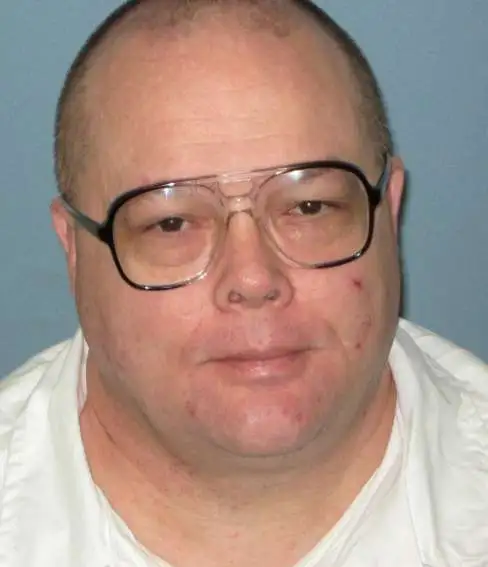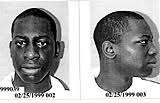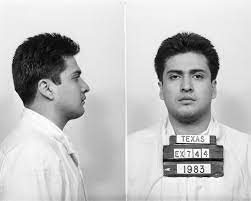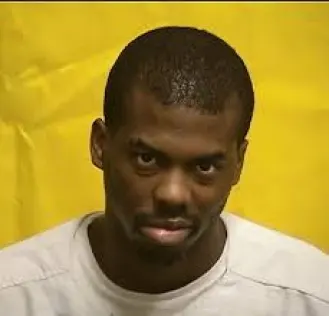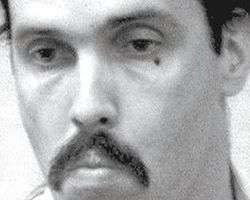Thomas Lane Murders Wife In Alabama
Thomas Lane was sentenced to death by the State of Alabama for the murder of his wife Theresa Lane
According to court documents Thomas Lane and Theresa Lane were separated and she was living at a friends house. The body of Teresa Lane would be found in a bathtub and she had been beaten to death
Thomas Lane would be arrested, convicted and sentenced to death
Thomas Lane Photos
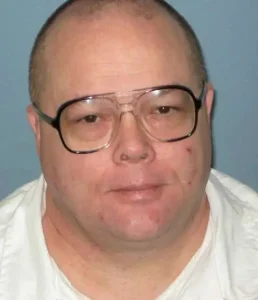
Thomas Lane FAQ
Where Is Thomas Lane Now
Thomas Lane is incarcerated at Holman Prison
Thomas Lane Case
The evidence adduced at trial indicated the following. Around 10:00 a.m. on Sunday, October 12, 2003, Pelagia Wilson returned to her home on 15th Street in Irvington from her all-night babysitting job and found Theresa, her roommate, dead in the bathtub. Wilson testified that when she found her Theresa was completely submerged under the water. Dr. Leszek Chrostowski, a forensic pathologist, went to the scene and removed Theresa’s body from the bathtub; he performed an autopsy on Theresa the following morning, October 13, 2003. Dr. Chrostowski testified that the cause of Theresa’s death was drowning and that the manner of death was homicide. Dr. Chrostowski based his determination on the following findings: (1) that Theresa had foam around her mouth when she was found, indicating that she had water in her lungs; (2) that she had petechial hemorrhaging in her eyes, indicating that she had been asphyxiated; (3) that she suffered from “several blunt force impacts” (R. 672) to the top and back of her head that caused subdural hemorrhaging, indicating that she had hit her head on the bathtub numerous times; (4) that she had bruises on her right shoulder and chest area, indicating that she had been held down; and (5) that she had numerous bruises on both of her forearms, on both of her elbows, on her right thigh, on her right knee, and on her right ankle, all of which Dr. Chrostowski described as defensive wounds. In Dr. Chrostowski’s opinion, the pattern of bruising, coupled with the hemorrhaging on the skull and in the eyes and the foam around her mouth, indicated that Theresa had been pushed down into the water in the bathtub and forcibly held underwater as she thrashed around and fought her attacker before she ultimately drowned.
The State presented evidence indicating that Thomas Lane had met Theresa, a native of the Philippines, in the mid 1990s, over the Internet. After an “Internet courtship,” Lane married Theresa and brought her to the United States. Lane and Theresa were married for approximately nine years when, in late June 2003, Theresa and Lane separated. Theresa moved in with her friend, Wilson, and Lane stayed in the couple’s mobile home. On July 3, 2003, Theresa retained an attorney to begin divorce proceedings. On July 10, 2003, Theresa removed Lane as the beneficiary on her $161,000 life insurance policy-obtained through her employer, a local Wal-Mart discount department store-and made her sister the beneficiary.
Testimony indicated that Thomas Lane and Theresa’s divorce was initially uncontested; however, issues subsequently arose that delayed the divorce.3 The delay upset Lane because immediately following his separation from Theresa Lane began “shopping” on the Internet for a new “mail-order bride” from the Philippines, and he had already selected Lorna Abe to be his new bride. Evidence was presented indicating that Lane was under both time and financial constraints to bring Abe to the United States based on demands made by his prospective bride’s father. Documents seized from Lane’s mobile home and computer evidenced Lane’s “Internet courtship” with Abe. Included in the documents were numerous e-mails between Lane and Abe; various “on-line” conversations between Lane and Abe; e-mail receipts from Western Union showing that Lane had repeatedly wired money to Abe, despite the fact that Lane was unemployed at the time; and an e-mail receipt showing that Lane had sent Abe flowers. In addition, evidence was presented indicating that Thomas Lane had bragged to various family members, friends, and neighbors about his new bride and that he had filed paperwork with the Immigration and Nationalization Service and the Department of Homeland Security seeking to bring Abe-whom he termed his fiancée-to the United States.4
The State presented testimony that during the three months after their separation and leading up to Theresa’s murder, Thomas Lane harassed Theresa’s divorce attorney as well as Theresa, in an attempt to speed up the divorce, and that, on more than one occasion, Lane had threatened to kill Theresa. Specifically, Theresa’s divorce attorney testified that Lane contacted him-by telephone and in person-in excess of 20 times after he was retained by Theresa in July 2003, in an attempt to persuade Williams to “speed up” the divorce. At one point, the attorney said, Lane showed him a photograph of a young woman and said that she was “waiting on him” and that he needed a quick divorce. (R. 904.) The attorney also testified that a court date regarding possession of Theresa’s truck, see infra note 3, was scheduled for October 15, 2003, two days after Theresa’s murder.
Testimony also indicated that Thomas Lane went to Wilson’s home, where Theresa was living, approximately two weeks before Theresa’s murder and banged on the door trying to get in; that Theresa often rode to work with one of her friends, Charlene Gilmore, and that they would always take different routes to and from the Wal-Mart store because they were afraid that Lane was following them; and that Lane left a threatening message on Theresa’s voicemail on her cellular telephone approximately three weeks before the murder. Robert Lane (“Robert”), Lane’s father, testified that when Lane visited him in North Carolina in September 2003, approximately three weeks before Theresa’s murder, Lane told him about the separation and said: “[I]f I thought I could do what [Scott] Peterson [5 ] did and get away with it, I’d kill her.” (R. 458.) Additionally, Tony Bazzel, a friend of Lane’s, testified that sometime before Theresa’s murder, Lane told him that “he would kill Theresa” and that “he would put three bullets in her head if he thought he could get away with it.” (R. 782.)
On the morning of the murder, Thomas Lane was seen by neighbors at his mobile home between 8:00 a.m. and 8:30 a.m. Lane told neighbors that he was going out to get some coffee and doughnuts because he had worked all night, and he then left in his late 1970s model pea-green Ford half-ton pickup truck. Melissa Bruno, one of the neighbors who had seen Lane that morning, testified that Lane’s dog was very upset that morning and that Lane told her that it was because he could not go with Lane to get the coffee and doughnuts. However, Bruno said that, in the time she had known him, Lane had always taken his dog with him everywhere. As soon as Lane left, his neighbors also left to go to church; when they returned home at approximately 9:30 a.m., Lane’s truck was parked in front of his mobile home.
At approximately 8:30 a.m. that morning, Wilson’s neighbor, James Jay-a mechanic-saw what he described as a 1975 to 1978 model pea-green Ford pickup truck parked across the street from Wilson’s house. At trial, Jay identified a photograph of Thomas Lane’s truck as the truck he had seen parked across the street from Wilson’s house that morning. Jay testified that he saw a person get out of the truck and walk to the front porch of Wilson’s home, at which point Jay’s view of the person became obstructed by shrubbery. Testimony indicated that it took between 10 and 15 minutes to drive from Lane’s mobile home to Wilson’s house.
At approximately 11:00 a.m. on the morning of the murder, Lane visited his friend, Tony Bazzel, at Bazzel’s house. According to Bazzel, Thomas Lane was pacing and he was fidgety. Bazzel’s wife, Vervena, returned home from church at approximately noon and received a telephone call. Because Vervena conducted the conversation in Tagalog-a Philipino language-Bazzel did not understand what was being said. However, based on his wife’s mention of the name “Theresa” and her demeanor, Bazzel believed that she had been told that something was wrong with Theresa. Bazzel conveyed his conclusion to Lane, to which Lane replied, “I know.” (R. 786.) When Lane asked Vervena about the telephone call, however, she refused to give him any details. Lane then left Bazzel’s home; he returned approximately half an hour later and told Bazzel that “he had heard” that Theresa had been found dead. (R. 787.) Bazzel told Lane that he believed Lane was a suspect, and Lane responded that he “was familiar with the system,” and would “find some bail money and a lawyer.” (R. 787.) Lane then left.
After Wilson discovered Theresa’s body at approximately 10:00 a.m ., she telephoned emergency 911, and both law-enforcement and emergency-medical personnel came to the scene. Sergeant Mitch McRae, supervisor of the major-crimes division of the Mobile County Sheriff’s Department, was in charge of investigating Theresa’s death. He arrived at the scene at approximately 1:00 p.m., after Theresa’s body had been removed. Based on the fact that there were no signs of forced entry and that nothing appeared to be missing from the house, Sgt. McRae determined that Theresa’s death was suspicious; however, until the cause and manner of death were positively determined by an autopsy, there was no crime. Nonetheless, Sgt. McRae wanted to speak with Lane to notify him of Theresa’s death and to get information regarding Theresa’s general health.6
Deputy Erik Travis Leddick, a patrol deputy with the Mobile County Sheriff’s Department, stopped Thomas Lane as he was driving his truck on Padgett Switch Road, approximately one and a half miles from Wilson’s house, sometime between 1:00 p.m. and 2:00 p.m. the day of the murder. Deputy Leddick directed Lane to the back of his truck and they waited for Sgt. McRae to arrive to speak to Lane. Deputy Leddick said that Thomas Lane continually asked him what had happened to his wife, and spontaneously stated: “I don’t even know where she lives.” (R. 573.) While waiting for Sgt. McRae to arrive, Deputy Leddick noticed a wet bath towel in Lane’s truck.
Sgt. McRae arrived on the scene shortly before 2:30 p.m. Sgt. McRae and Lane sat in Sgt. McRae’s vehicle, and Sgt. McRae advised Lane of his Miranda7 rights. Lane waived his rights, executed a waiver-of-rights form, and agreed to speak with Sgt. McRae. In his statement, Thomas Lane said that he had been home all night the night before and that he had waked up at approximately 9:00 a.m. that morning, at which time he contacted Abe over the Internet. After spending some time on the Internet, Lane said, he went to Bazzel’s house and then found out about Theresa’s death. Lane told Sgt. McRae that Theresa was his “mail-order bride.” Lane advised Sgt. McRae that he and Theresa had been married for approximately nine years; he stated that although they were separated and in the process of getting a divorce, their marriage had been a generally “happy” one. When questioned about any instances of domestic violence, Lane stated that there had been one instance, approximately four years earlier, when he “grabbed” Theresa’s arm during an argument, leaving a bruise. Lane told Sgt. McRae that he was “fine” with the divorce and that he just wanted Theresa to be happy. According to Thomas Lane, he had not seen Theresa for three weeks and did not know where she was living. Following the interview, Lane was allowed to leave.
Sgt. McRae testified that he did not inform Thomas Lane about any of the details of Theresa’s death. However, the State presented testimony from various friends and neighbors of Lane that on the evening of the murder, Lane told a number of people that Theresa had been found dead in the bathtub earlier that day, and that she had either had an aneurysm and drowned accidentally or had been held underwater and murdered. Lane said that he would probably be blamed for her death, and he asked several people to say that they had seen him at home at the time of Theresa’s death that morning; they all refused to lie for Lane.
In addition, the State presented testimony that Lane attempted to collect on Theresa’s life-insurance policy the afternoon of her murder. Specifically, Ron Pierce, a chaplain with the Mobile County Sheriff’s Department, testified that Thomas Lane telephoned him at approximately 4:30 on the afternoon of the murder and asked him for “paperwork” to present to Wal-Mart so that he could collect on Theresa’s life insurance. (R. 999.) In addition, at approximately 5:00 p.m. the day of the murder Lane went to the Wal-Mart store where Theresa worked and asked about Theresa’s life insurance. Lane was told that the personnel manager, who was in charge of employees’ insurance, was not working that Sunday and that he would have to come back the following day. Lane returned to Wal-Mart on Monday and was informed that he was no longer the beneficiary on Theresa’s life-insurance policy.
The State presented evidence that Thomas Lane had retained attorney Buzz Jordan on October 6, 2003, the Monday before Theresa’s murder, to represent him in the divorce proceedings. A receipt from Jordan’s records was introduced into evidence by the State showing that Lane paid Jordan $500 by check on October 6, 2003. Telephone records introduced by the State indicated that Lane telephoned Jordan’s office the day of the murder, at 1:34 p.m., and that he telephoned the office six times the following day, Monday, October 13, 2003. A receipt from Jordan’s records indicated that Lane paid Jordan $1,000 in cash the day after the murder, October 13, 2003. In addition, Jordan testified that he spoke with Lane the day after Theresa’s murder; that Lane gave him $1,000 in cash. After speaking with Thomas Lane, Jordan told Lane to bring his home computer to Jordan’s office. Lane brought the computer “tower” containing the hard drive of his computer to Jordan’s office. Jordan’s secretary, Donna Beech, testified that she received the computer tower from Lane on October 13, 2003, and that, at the direction of Jordan, she accessed the hard drive on October 23 and October 24, 2003, and printed several documents. She said that she did not alter or delete any files or documents on the hard drive.
Although, as noted above, no signs of forced entry were noticed the day of the murder, further investigation the day after the murder showed that the front door of Wilson’s house had been pried open with some sort of tool. In addition, approximately three days after the murder, Wilson reported that $3,600 in cash as well as several pieces of jewelry were missing from her home. The jewelry was never found.
At approximately 3:30 p.m. the day after Theresa’s murder, Thomas Lane was arrested. Subsequently, search warrants were obtained for Lane’s mobile home and his truck. When law-enforcement officers searched Lane’s mobile home, they discovered that the computer tower was missing; they eventually obtained the computer tower from Jordan. During the search of Lane’s truck, several tools were seized.
As noted above, documents seized from Thomas Lane’s mobile home and computer evidenced his search for a new “mail-order bride” following his separation from Theresa. Marty Irvin, a database-systems investigator with the Mobile County Sheriff’s Department, testified that he examined Lane’s hard drive and that it showed that Lane was not on the Internet at the time of Theresa’s murder, as Lane had previously told Sgt. McRae. However, Irvin said that he discovered during his examination of the hard drive that Lane had changed the background picture on his monitor from a photograph of himself and Theresa to a pornographic photograph of Abe. Irvin also testified that, although the attorney’s secretary had accessed the hard drive while it was in her possession, she had not altered or deleted any files on the hard drive. This change was made at 10:23 a.m. on the morning of the murder.
The tools seized from Thomas Lane’s truck were examined by the Alabama Department of Forensic Sciences (“DFS”) and compared to the marks found on the front door of Wilson’s house. Scott Milroy, a firearms and toolmarks examiner with DFS, testified that a chisel found in Lane’s truck matched one of the marks found on Wilson’s front door. Milroy said that “without a doubt” the chisel from Lane’s truck had made that mark on the front door of Wilson’s house. (R. 710.) The details on the remaining marks on the door were not specific enough to determine whether they were made by the chisel or by any of the other tools found in Lane’s truck.
Finally, the State presented evidence indicating that after his arrest, while he was in the Mobile Metro Jail, Thomas Lane admitted to murdering Theresa. Scott Bruno, one of Lane’s neighbors8 who was serving time in the Mobile Metro Jail for a misdemeanor conviction at the time of Lane’s arrest, testified that Lane told Bruno that he had “confessed” to murdering Theresa to several people at church but that his confessions could not be used against him because of the “sanctity of the church.” (R. 971.) In addition, Kevin Szabo, who at the time of trial was in a federal penitentiary in Indiana for a series of bank robberies, testified that while he was housed in the Mobile Metro Jail awaiting trial, Lane confessed that he had murdered Theresa. According to Szabo, at one point Thomas Lane said: “I can’t believe I drowned my damn wife.” (R. 980.) During another conversation about what people are willing to do to get money, Lane said, “tell me about it. The insurance money got me in here.” (R. 980.) Lane then told Szabo that he had thought he was the beneficiary on Theresa’s life-insurance policy and that he was angry when he found out th at he was not the beneficiary because he had wanted to get a new “mail-order bride.” Thomas Lane also described the murder to Szabo-that “he had held [Theresa] down with his leg and she had scratched him and he held her in the bathtub under the water.” (R. 981.)
https://caselaw.findlaw.com/court/al-court-of-criminal-appeals/1507261.html

